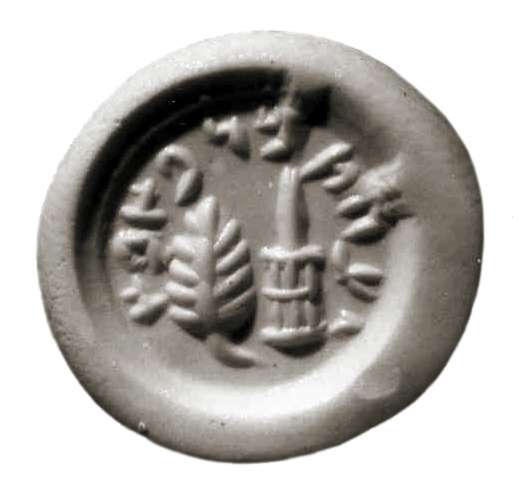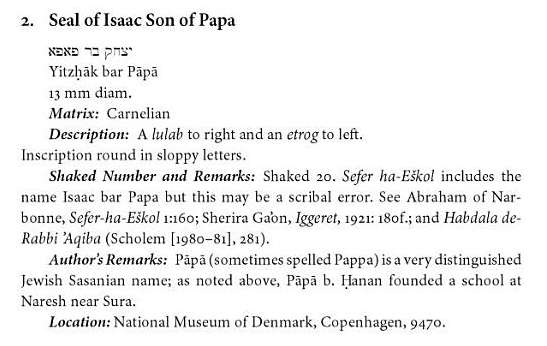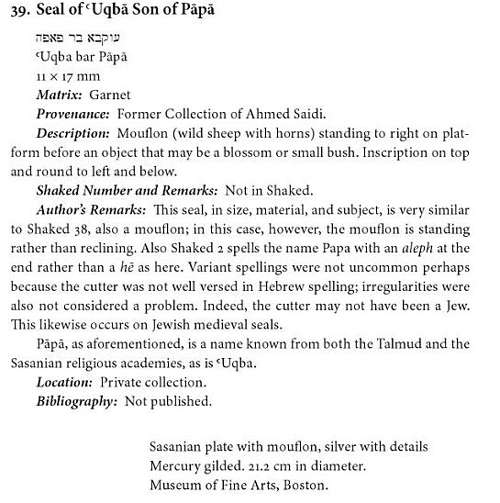Here is a Jewish Sasanian seal (between 3rd and 7th centuries CE) described as: Lulav and etrog, with the Hebrew inscription, "Isaac, son of Papa". Copenhagen, National Museum, inv. 9470. Cornelian, 13 mm (note that פפא is spelled פאפא).

Sasanian Jewry and its culture: a lexicon of Jewish and related seals by Daniel M. Friedenberg, pg. 28:

Another seal is mentioned as well:

Regarding spelling variants, I would just point out that there basically is no such thing as standardized spelling 1500 years ago. In fact there basically was no such thing as fully standardized spelling 500 years ago. To the extent that there is a canonical literature, spelling could be more standardized. For example, because of our Bible no one ever had a doubt how to spell a name like יהודה or משה, but newer names and words could be challenging and subject to the whims of the writer, who had no official dictionaries or lexicons to consult. That's why "Akiva" was spelled עקיבה or עקיבא, and there are many variant spellings in all languages.
Interestingly, there appears to be a Ge'onic variant of Kiddushin 70b's יהודה בר פפא ממזירא which reads יצחק בר פפא ממזירא, which is supported by the Munich Talmud MS. See אוצר הגאונים.





This is not really an issue of standardization but dialectical and regonial variation. עקיבא anf עקיבה is a perfect example of this. Open a Yerushalmi and then open a Bavli.
ReplyDeleteAs I'm sure you're aware, Papa is an extremely common name in Mesopotamia (and beyond) among Jews, Christians, and others. Based on the iconography and the script, though, this guy is clearly Jewish.
I've heard somewhere (who knows, it could've even been at your site) that none of the bar papas in the hadran appear anywhere in the Talmud. If true, I'm not sure what to make of that.
ReplyDelete-Phil
Shai, you're the expert, but of course I'm aware that the Yerushalmi and Bavli spell it differently. In fact, that's the example which popped into my head. I guess I could be wrong but my thinking was that the reason why there could be two spellings for the same name (indeed, the same person) is because there never was an authority to declare from on high how this name was to be spelled. Hebrew orthography won't vary as much as English, guided by the fact that the consonants are mostly distinct sounds. But the א and ה at the end are good examples of where this breaks down.
ReplyDeletePhil, some of them do appear in the Talmud. For example, רכיש בר פפא is on Chulin 42b. I don't know which came first, the chicken or the egg, but the names in the siyum list appear in kabbalistic works like Sefer Raziel. Also see here.
Shoudl be moted that all the Bar Papas lived in different periods, and contrary to popular belief, were not sons of the same man. Should also be noted that they became the subject of a popular French television cartoon series named "Bar-ba-Papas" in the 1970s, which I enjoyed growing up in Canada. You can see some episodes on Youtube or Wikiepdia under "Barbapapas".
ReplyDeleteDF
You know the story at the very beginning of ספר אור זרוע, about the spelling of the name עקיבה?
ReplyDeleteYes.
ReplyDeleteThe Rambam's copy of the mishna spelled Akiva with a heh, FWIW.
ReplyDeletein at least some versions of the eshkol, when writing the papas that we should be saying at a siyyum, it has yitzchak instead of acha
ReplyDeleteRabbi Chaim Kanievky, in Siach Hasadeh somewhere, has a list of at least 100 Papaides.
ReplyDeleteThat's why I'm not R. Chaim Kanievsky. Or one of the reasons.
ReplyDeleteIf you want to get all fancy though, I think Pappasides works a little better.
Is there any other evidence of the type of Hebrew script used by the Jews for Aramaic in Sassanid Mesopotamia?
ReplyDeleteSubsribin'..
ReplyDelete